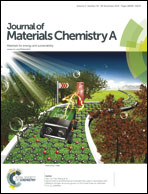Durability analysis of polymer-coated pristine carbon nanotube-based fuel cell electrocatalysts under non-humidified conditions†
Abstract
A polymer electrolyte fuel cell (PEFC) that shows high durability at elevated temperature and under non-humidified conditions is strongly demanded for the next generation PEFCs. Here we show the importance of using pristine carbon nanotubes (CNTs) as catalyst supports for fuel cell (FC) durability. For that purpose, two different membrane electrode assemblies (MEAs) using pristine CNTs and commercial carbon black (CB) as carbon supports were coated by polybenzimidazole on which platinum (Pt) nanoparticles were deposited. Notably, the CNT-based MEA exhibited ∼4 times higher durability compared to the CB-based MEA. The ex situ monitoring of the fabricated electrocatalysts before and after the durability testing based on transmission electron microscopy and X-ray diffraction measurements revealed higher structural stability of the CNTs compared to the CB in their MEAs. The pristine structure of the CNTs has been revealed to be very important for the high PEFC durability. This is the first report that shows the durability of the pristine CNT-based PEFC at high operating temperature and under non-humidified conditions, which are the targets of the next generation PEFCs with very high performance.


 Please wait while we load your content...
Please wait while we load your content...